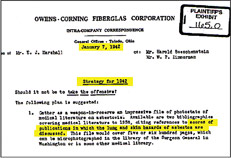Asbestos Manufacturer Internal Documents
Internal corporate documents of numerous asbestos manufacturers and corporations confirmed that they had actual knowledge about the dangers and hazards of asbestos exposure as early as the 1930's, but hid or suppressed that information from workers and from the public.
Asbestos exposure was reported to cause lung cancer as early as the 1930's. Animal testing at the Saranac Laboratory, sponsored by the asbestos industry, confirmed that mice being exposed to asbestos dust contracted lung cancer. Yet a medical article about the Saranac asbestos study that was published in a peer-reviewed medical journal contained no reference to mice contracting cancer. Attorneys for an asbestos manufacturer deleted the section on cancer from the final draft of the report!
Though the asbestos industry had a wealth of information about the dangers of asbestos through the 1930's and 1940's, their marketing material proclaimed that their asbestos products were "non-toxic" and "promoted workers" well being. Pictures on asbestos product brochures up to the 1970's showed workers cutting and sawing asbestos products without any respiratory protection.
From 1943 to 1964, the world's use of raw asbestos quadrupled from 500,000 tons to 2 million tons per year. This failure to protect employees from asbestos has been called the worst occupational health disaster in U.S. history.
Even today, asbestos is mined in Canada, Russia, and other countries for export to unsuspecting workers in Third World and developing countries!
To see excerpts of the internal documents of certain asbestos manufacturers, take a look through our "Cites:" Trial Exhibits of Internal Corporate Documents.

A 1942 internal document to Owens Corning corporate executives cites the "hazards of asbestos" and makes reference to more than 500 pages of medical articles on the subject. Owens Corning continued to sell asbestos well into the 1970's.
Please Contact Us
to answer any questions
you may have.


